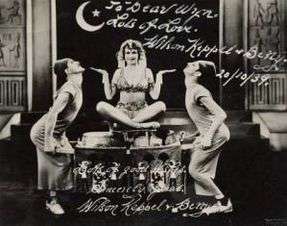Eccentric dance
Eccentric dance is a style of dance performance in which the moves are unconventional and individualistic. It developed as a genre in the United States in the late 19th and early 20th centuries as a result of the influence of African and exotic dancers on the traditional styles of clog and tap dancing. Instead of holding the body stiff and straight in the style of a jig, acrobatics such as flips and contortions were used in a more exuberant, expressive and idiosyncratic way.[2]

The style was used in stage performances such as minstrel shows, music hall or vaudeville.[3][4] Dance styles which used eccentric moves and encouraged improvisation, such as the Charleston, became popular crazes in the 1920s. It was used in movies to provide comic relief.[5]
Early distinctive forms of eccentric dancing had names like rubber legs or legomania. Rubberlegging involved leg shaking or snaking which later evolved into Shag and the showcase style of Elvis Presley, while legomania added leaps and kicks in the air. An example of legomania is Ray Bolger's performance as the Scarecrow singing "If I Only Had a Brain" in The Wizard of Oz.[6]
Joel Schechter describes eccentric dance as the "vaudevillian impulse to dance like crazy, even if the legs do not agree with the upper torso, or the music, about which way to go."[7] Marshall Winslow Stearns defines it as follows:
The term "eccentric" is a catchall for dancers who have their own non-standard movements and sell themselves on their individual styles. It has been used to describe a variety of highly personal performances by dancer-comedians on Broadway. Thus, George M. Cohan, Leon Errol, Joe Frisco, George White, Harland Dixon, Jack Donahue, James Barton, Tom Patricola, Hal Leroy, Buddy Ebsen, and Ray Bolger have all been labeled eccentric dancers at one time or another, although some are much more than that, and James Barton, for example, used eccentric movements along with a wealth of other and perhaps finer steps.[3]
Eccentric dancers
|
|
See also
References
Notes
- Wilson, Keppel and Betty, V&A,
Wilson, Keppel and Betty formed the greatest eccentric dance act of all time.
- "Eccentric Dancing", Vaudeville Old & New: an encyclopedia of variety performances in America, Vol. 1, Psychology Press, 2004, p. 346, ISBN 978-0415938532
- Stearns, Marshall Winslow and Stearns, Jean (1968). Jazz Dance: The Story of American Vernacular Dance. Da Capo Press. p. 232.CS1 maint: multiple names: authors list (link)
- "Eccentric dance". Streetswing. Retrieved 2015-02-03.
- Delamater, Jerome. Dance in the Hollywood musical. p. 83.
Eccentric dancers' major contribution to film dance is that of humor. ...
- Lewis, Lisa (2013), Beginning Tap Dance, p. 106, ISBN 978-1450411981
- Schechter, Joel. The Pickle Clowns: New American Circus Comedy. p. 37.
- Staff (September 2, 1967). "Joe Bennett Dies. Vaudeville Dancer". The New York Times. Retrieved 2015-02-03.
Joe Bennett, a vaudeville headliner early in the century whose specialty was eccentric dancing, died yesterday...
- Cohan, George M. (1915). "The Stage As I Have Seen It". Green Book Magazine. Retrieved 2015-02-06.
I was twelve years old when I developed my eccentric dance. ...
- Staff (January 25, 1930). "Gordon Dooley Dies. Noted in Vaudeville, Comedian and Eccentric Dancer, the Last of Three brothers, a Victim of Pneumonia". The New York Times. Retrieved 2015-01-06.
- The First Hollywood Sound Shorts, 1926-1931, McFarland, 2005, p. 43, ISBN 0786410302
- Jonathan Law, The Methuen Drama Dictionary of the Theatre, p. 534, ISBN 140813148X
- Windsor, Barbara (17 Nov 2011), Wilson, Keppel and Several Bettys, BBC,
Wilson, Keppel and Betty formed one of the greatest eccentric dance acts of all time
Further reading
- Harker, Brian (2008). "Louis Armstrong, Eccentric Dance, and the Evolution of Jazz on the Eve of Swing". Journal of the American Musicological Society. University of California Press. 61 (1): 67–121. doi:10.1525/jams.2008.61.1.67. JSTOR 10.1525/jams.2008.61.1.67.
- Wilkie, Ian (2017). "Funny walking: the rise, fall and rise of the Anglo-American comic eccentric dancer" (PDF). Comedy Studies. 8 (2): 182–196. doi:10.1080/2040610X.2017.1343971.